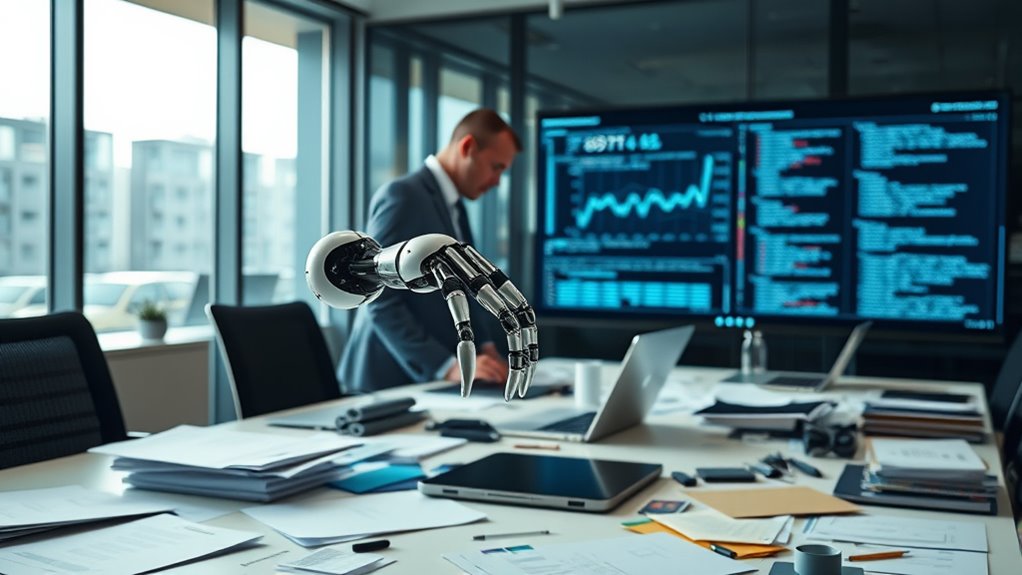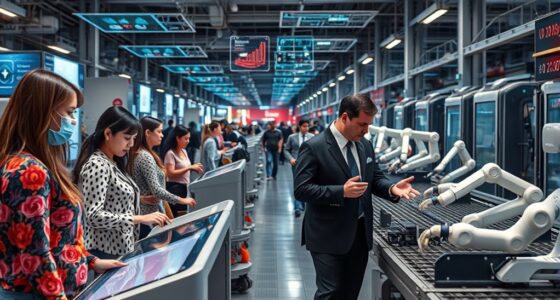Generative AI is quietly replacing many white-collar tasks by automating routine, data-driven work in finance, law, tech, and customer service. It handles tasks like report generation, legal briefs, and customer support, reducing the need for human involvement. As AI advances, more roles face obsolescence, especially those with repetitive duties. To understand how this shift impacts your job and what strategies companies are adopting, stay with us for more insights.
Key Takeaways
- Generative AI automates routine, data-driven tasks like report writing, legal briefs, and customer service, reducing human involvement.
- It enhances decision-making and collaboration, gradually replacing roles that require communication, supervision, and documentation.
- Companies are expanding AI integration beyond pilots, creating centralized centers to govern and deploy AI across functions.
- AI’s rapid advancements increase productivity and personalization, subtly shifting job requirements and reducing traditional roles.
- Skilled professionals face automation in tasks like analysis and strategy, leading to job polarization and new skill demands.
The Shift in White-Collar Work Dynamics

The landscape of white-collar work is undergoing a rapid transformation driven by AI advancements. You’ll notice hiring has slowed markedly across sectors like finance, tech, consulting, and law, especially for entry-level roles such as analysts, junior lawyers, and HR associates. Despite rising profits and productivity, job growth has stagnated or declined, signaling a structural shift rather than a recession. AI’s “Super-Exponential Effect” accelerates displacement, replacing routine tasks faster than ever. This change marks the end of the “Quiet Erosion,” where AI gradually absorbed jobs without layoffs. Now, AI-driven efficiency is causing a major realignment in employment patterns, with many roles becoming obsolete or severely reduced. You’ll need to prepare for a job market that’s shifting quickly, demanding new skills and adaptability. According to recent data from the BLS, overall professional job openings in the U.S. have reached their lowest levels since 2013, further underscoring the scale of this structural shift.
Tasks Most Vulnerable to AI Automation

Tasks involving routine, repetitive, or data-processing work are most vulnerable to AI automation. These jobs include administrative tasks like data entry, legal brief writing, and customer service. AI accelerates automation in roles that rely on standard protocols, often reducing the need for human oversight. Manufacturing and middle-management roles with repetitive physical or cognitive duties face significant risks as AI tools handle these tasks more efficiently. Here’s a quick overview:
| Task Type | Vulnerability |
|---|---|
| Data entry and paperwork | Highly susceptible |
| Customer service roles | Up to 65% could be automated |
| Legal and compliance work | AI can generate briefs or reports |
| Manufacturing tasks | Repetitive physical/cognitive work |
| Supervisory roles | Automation of oversight tasks |
These trends show how automation threatens many entry-level and repetitive positions. The pace of AI advancements is increasing rapidly, further expanding the range of tasks that can be automated. Additionally, the standard protocols that underpin many routine jobs make them particularly easy targets for AI-driven efficiency gains.
Skill Gaps and the Changing Job Market

As AI automates routine white-collar tasks, a widening gap emerges between the skills you have and those in demand. You need advanced digital literacy, especially in AI management, development, and oversight, but qualified candidates are scarce. Entry-level roles shrink, reducing hands-on learning and deepening skill gaps. If you don’t reskill or upskill in AI-related competencies, your traditional skills risk obsolescence. Employers struggle to find workers who can effectively collaborate with AI systems and interpret their outputs. Job displacement hits sectors like finance and law hardest, causing job polarization—high-skill roles grow while middle-skill jobs decline. This shift pressures wages downward, as companies justify cost cuts, offshore work, and devalue traditional credentials, intensifying competition and threatening social mobility across the workforce. Research indicates that over 50% of tasks by market research analysts and sales reps could be replaced by AI, further accelerating these trends and highlighting the urgent need for workforce adaptation. Additionally, the skill gap continues to widen as the demand for specialized knowledge outpaces the supply of qualified professionals.
Corporate Strategies and Workforce Adaptation

By 2025, most companies plan to expand AI beyond pilot projects, integrating it across multiple functions to build enterprise-wide solutions. You’ll see a co-intelligence approach, where AI enhances human decision-making rather than replacing it, fostering collaboration. Centralized AI centers of excellence will coordinate governance, decision-making, and implementation, creating cohesive AI ecosystems through platform-centric or aggregator models. Companies are investing heavily in training programs to develop AI-ready teams, emphasizing a people-centric approach to change management. Retention efforts focus on employees with advanced digital skills. Many organizations are automating routine tasks with AI agents, boosting productivity by around 7.8%. Additionally, AI-driven marketing and customer service improve personalization and efficiency, helping you deliver better experiences while optimizing operational workflows. Recognizing the importance of Personality Test insights can also aid in tailoring AI interactions to better suit individual employee and customer needs.
Future Implications for Knowledge-Based Professions

Generative AI is transforming knowledge-based professions by substantially increasing automation potential, especially in roles that rely heavily on decision-making and collaboration. Since 2017, automation in expertise application has risen 34 percentage points, driven by natural language understanding. Tasks like communication, supervision, documentation, and interaction—once considered non-automatable—are now increasingly automated. Professions requiring advanced language skills, such as education, technology, law, and finance, are adopting AI faster. Disruption is most significant in higher-wage, highly educated roles, affecting over 30% of workers’ tasks—particularly administrative and evaluative work. While productivity for skilled workers can increase nearly 40%, misusing AI risks drops of about 19%. Ultimately, knowledge-based professions face a future where task shifts and productivity gains reshape workflows and skill requirements.
Frequently Asked Questions
How Quickly Will AI Fully Automate White-Collar Jobs Across Industries?
You wonder how fast white-collar jobs will be fully automated across industries. While automation is accelerating, experts estimate it’ll take roughly 20 years to automate half of all work tasks globally. In the near term, expect significant disruptions, especially in entry-level roles, with some sectors like finance and tech seeing rapid AI adoption. However, complete automation remains gradual, giving workers time to adapt and reskill for evolving job markets.
What Are the Best Strategies for Workers to Future-Proof Their Careers?
Think of your career as a garden. To keep it thriving amid changing weather, you need to plant diverse, resilient seeds. You should focus on lifelong learning, honing skills AI can’t replicate—like creativity and emotional intelligence. Embrace adaptability, collaborate with AI tools, and explore new sectors or remote opportunities. By nurturing your unique capabilities, you’ll guarantee your career remains vibrant and relevant, no matter how the landscape shifts.
How Will AI Impact Salary Structures in Knowledge-Based Professions?
AI is reshaping salary structures in knowledge-based professions by making compensation more dynamic and performance-driven. You’ll see higher pay for those with advanced AI skills, as companies value their expertise and use real-time analytics to adjust wages. Remote work and global competition also influence salaries, pushing them up or down based on regional factors. To stay competitive, you should continually upgrade your AI skills and adapt to this evolving, data-driven pay landscape.
What Ethical Considerations Arise From AI Replacing Human Decision-Makers?
You should consider the ethical implications of AI replacing human decision-makers. AI can inherit biases from training data, leading to unfair outcomes, and its “black box” nature makes decisions hard to interpret. Overreliance may diminish accountability, while privacy concerns and job displacement pose societal risks. To address these issues, guarantee transparency, develop regulatory frameworks, and promote human-AI collaboration that emphasizes ethical judgment and responsibility.
How Can Policymakers Effectively Regulate Ai-Driven Workplace Changes?
You can see that regulating AI-driven workplace changes requires clear, consistent policies. Policymakers should establish federal standards that complement state laws, ensuring uniformity. They need to promote transparency, mandate bias audits, and hold employers accountable for third-party AI tools. As an individual, you can stay informed about evolving laws, advocate for stronger regulations, and support organizations working toward fair AI employment practices. This approach helps balance innovation with employee rights.
Conclusion
As you navigate this evolving landscape, remember that AI now handles up to 40% of routine white-collar tasks, transforming your work environment. Embracing new skills becomes essential, as adaptability is your best asset. Instead of fearing automation, see it as an opportunity to focus on creative and strategic aspects. Staying ahead means continuously learning and evolving—after all, those who adapt fastest will thrive in this changing world.









